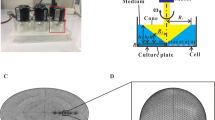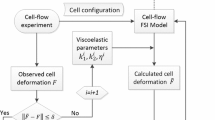Abstract
Intracellular \(\hbox {Ca}^{2+}\) transient induced by fluid shear stress (FSS) plays an important role in mechanical regulation of osteoblasts, but the cellular mechanism remains incompletely understood. Here, we constructed a mathematical model combined with experiments to elucidate it. Our simulated and experimental results showed that it was the delay of membrane potential repolarization to produce the refractory period of FSS-induced intracellular calcium transients in osteoblasts. Moreover, the results also demonstrated that the amplitude of FSS-induced intracellular calcium transient is crucial to the proliferation, while its duration is critical to the differentiation, of osteoblasts. Overall, the present study provides a way to understand the cellular mechanism of intracellular calcium transients in osteoblast induced by FSS and explains some of related physiological events.










Similar content being viewed by others
References
Albrecht MA, Colegrove SL, Friel DD (2002) Differential regulation of ER Ca2+ uptake and release rates accounts for multiple modes of Ca2+-induced Ca2+ release. J Gen Physiol 119:211–233
Allen FD, Hung CT, Pollack SR, Brighton CT (2000) Serum modulates the intracellular calcium response of primary cultured bone cells to shear flow. J Biomech 33:1585–1591
Berridge MJ, Bootman MD, Lipp P (1998) Calcium-a life and death signal. Nature 395:645–648. doi:10.1038/27094
Chen NX, Ryder KD, Pavalko FM, Turner CH, Burr DB, Qiu J, Duncan RL (2000) Ca(2+) regulates fluid shear-induced cytoskeletal reorganization and gene expression in osteoblasts. Am J Physiol Cell Physiol 278:C989–997
Donahue SW, Donahue HJ, Jacobs CR (2003) Osteoblastic cells have refractory periods for fluid-flow-induced intracellular calcium oscillations for short bouts of flow and display multiple low-magnitude oscillations during long-term flow. J Biomech 36:35–43
Genetos DC, Geist DJ, Liu D, Donahue HJ, Duncan RL (2005) Fluid shear-induced ATP secretion mediates prostaglandin release in MC3T3-E1 osteoblasts. J Bone Miner Res 20:41–49. doi:10.1359/JBMR.041009
Godin LM, Suzuki S, Jacobs CR, Donahue HJ, Donahue SW (2007) Mechanically induced intracellular calcium waves in osteoblasts demonstrate calcium fingerprints in bone cell mechanotransduction. Biomech Model Mechanobiol 6:391–398. doi:10.1007/s10237-006-0059-5
Grynkiewicz G, Poenie M, Tsien RY (1985) A new generation of Ca2+ indicators with greatly improved fluorescence properties. J Biol Chem 260:3440–3450
Hung CT, Allen FD, Pollack SR, Brighton CT (1996) Intracellular Ca2+ stores and extracellular Ca2+ are required in the real-time Ca2+ response of bone cells experiencing fluid flow. J Biomech 29:1411–1417
Jacobs CR, Yellowley CE, Davis BR, Zhou Z, Cimbala JM, Donahue HJ (1998) Differential effect of steady versus oscillating flow on bone cells. J Biomech 31:969–976
Kang M, Othmer HG (2009) Spatiotemporal characteristics of calcium dynamics in astrocytes. Chaos 19:037116. doi:10.1063/1.3206698
Kapur S, Baylink DJ, Lau KH (2003) Fluid flow shear stress stimulates human osteoblast proliferation and differentiation through multiple interacting and competing signal transduction pathways. Bone 32:241–251
Korhonen T, Hanninen SL, Tavi P (2009) Model of excitation-contraction coupling of rat neonatal ventricular myocytes. Biophys J 96:1189–1209. doi:10.1016/j.bpj.2008.10.026
Liedert A, Kaspar D, Blakytny R, Claes L, Ignatius A (2006) Signal transduction pathways involved in mechanotransduction in bone cells. Biochem Biophys Res Commun 349:1–5. doi:10.1016/j.bbrc.2006.07.214
Luo CH, Rudy Y (1994) A dynamic model of the cardiac ventricular action potential. I. Simulations of ionic currents and concentration changes. Circ Res 74:1071–1096
Papachroni KK, Karatzas DN, Papavassiliou KA, Basdra EK, Papavassiliou AG (2009) Mechanotransduction in osteoblast regulation and bone disease. Trends Mol Med 15:208–216. doi:10.1016/j.molmed.2009.03.001
Prentki M, Glennon MC, Thomas AP, Morris RL, Matschinsky FM, Corkey BE (1988) Cell-specific patterns of oscillating free Ca2+ in carbamylcholine-stimulated insulinoma cells. J Biol Chem 263:11044–11047
Robling AG, Burr DB, Turner CH (2000) Partitioning a daily mechanical stimulus into discrete loading bouts improves the osteogenic response to loading. J Bone Miner Res 15:1596–1602. doi:10.1359/jbmr.2000.15.8.1596
Rubin C, Turner AS, Bain S, Mallinckrodt C, McLeod K (2001) Anabolism. Low mechanical signals strengthen long bones. Nature 412:603–604. doi:10.1038/35088122
Ruiz-Ceretti E, DeLorenzi F, Lafond JS, Chartier D (1988) Insulin and the resting potential of hypoxic substrate-deprived myocardium. Can J Physiol Pharmacol 66:202–206
Schuster S, Marhl M, Hofer T (2002) Modelling of simple and complex calcium oscillations. From single-cell responses to intercellular signalling. Eur J Biochem/FEBS 269:1333–1355
Sun J, Liu X, Tong J, Sun L, Xu H, Shi L, Zhang J (2014) Fluid shear stress induces calcium transients in osteoblasts through depolarization of osteoblastic membrane. J Biomech 47:3903–3908. doi:10.1016/j.jbiomech.2014.10.003
Tay LH, Dick IE, Yang W, Mank M, Griesbeck O, Yue DT (2012) Nanodomain of Ca2+ of Ca2+ channels detected by a tethered genetically encoded Ca2+ sensor. Nat Commun 3:778
ten Tusscher KH, Noble D, Noble PJ, Panfilov AV (2004) A model for human ventricular tissue. Am J Physiol Heart Circ Physiol 286:H1573–1589. doi:10.1152/ajpheart.00794.2003
Thomas AP, Bird GS, Hajnoczky G, Robb-Gaspers LD, Putney JW Jr (1996) Spatial and temporal aspects of cellular calcium signaling. FASEB J 10:1505–1517
Toescu EC (1995) Temporal and spatial heterogeneities of Ca2+ signaling: mechanisms and physiological roles. Am J Physiol 269:G173–185
Wang J, Huang X, Huang W (2007) A quantitative kinetic model for ATP-induced intracellular Ca2+ oscillations. J Theor Biol 245:510–519. doi:10.1016/j.jtbi.2006.11.007
Wiesner TF, Berk BC, Nerem RM (1997) A mathematical model of the cytosolic-free calcium response in endothelial cells to fluid shear stress. Proc Natl Acad Sci USA 94:3726–3731
Wong AY, Klassen GA (1995) A model of electrical activity and cytosolic calcium dynamics in vascular endothelial cells in response to fluid shear stress. Ann Biomed Eng 23:822–832
You J, Jacobs CR, Steinberg TH, Donahue HJ (2002) P2Y purinoceptors are responsible for oscillatory fluid flow-induced intracellular calcium mobilization in osteoblastic cells. J Biol Chem 277:48724–48729. doi:10.1074/jbc.M209245200
You J, Reilly GC, Zhen X, Yellowley CE, Chen Q, Donahue HJ, Jacobs CR (2001) Osteopontin gene regulation by oscillatory fluid flow via intracellular calcium mobilization and activation of mitogen-activated protein kinase in MC3T3-E1 osteoblasts. J Biol Chem 276:13365–13371. doi:10.1074/jbc.M009846200
Acknowledgments
We gratefully acknowledge that this study was funded by the National Natural Science Foundation of China (No. 11372244 and No.31170893).
Author information
Authors and Affiliations
Corresponding author
Ethics declarations
Conflict of interest
The authors declare that they have no conflict of interest.
Human and animal participants
The study does not involve human or animal subjects, uses commercial cell lines, and no further ethical approval is needed.
Appendix: Model Equations
Appendix: Model Equations
FSS-induced \(\hbox {Ca}^{2+}\) transients in osteoblasts were described as the following equations:
where
\(k_{\mathrm{ATP} }\)=100 \(\upmu \)M\(^{-1}\)s\(^{-1}\), if Ca \(_{\mathrm{s}}\) was higher than 1 \(\upmu \)M, else \(k_{\mathrm{ATP} }\)= 0;
\(I_{\mathrm{NaK}}\) was computed with the model of NaK ATPase taken from the model of Luo and Rudy (1994);
\(\hbox {Ca}^{2+ }\) current of L-VSCCs, \(I_{\mathrm{CaL}}\) was obtained with the model of Tusscher et al. (2004) and \(\hbox {Ca}^{2+}\) influx through L-VSCCs was described by
IP\(_{3}\) production, P, and \(\hbox {Ca}^{2+}\) activating PKC, K, were from the model of Kang and Othmer (2009).
\(\gamma _{s}\) was the ratio of cytoplasmic volume to the volume of small space;
Na\(^{+}\) and K\(^{+}\) current of SACs was described by the equations:
\(G_{\mathrm{SAC,Na}}\) and \(G_{\mathrm{SAC,K}}\) were the max conductance of Na\(^{+}\) and K\(^{+}\) current through SACs. \(P_{\mathrm{SAC}}\) was the open probability of SACs, which was set to one or zero based on our experimental results (Fig. 3). \(E_{\mathrm{Na}}\) and \(E_{\mathrm{K}}\) are obtained with Nernst equation.
Rights and permissions
About this article
Cite this article
Sun, J., Xie, W., Shi, L. et al. Simulation of intracellular \(\hbox {Ca}^{2+}\) transients in osteoblasts induced by fluid shear stress and its application. Biomech Model Mechanobiol 16, 509–520 (2017). https://doi.org/10.1007/s10237-016-0833-y
Received:
Accepted:
Published:
Issue Date:
DOI: https://doi.org/10.1007/s10237-016-0833-y




